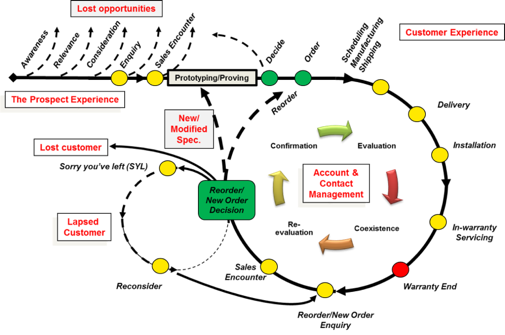Top 5 Obstacles to B2B Customer Centricity # 2 Multi-channel Journey
The Top Five Obstacles to Customer Centricity in B2B Companies and How to Overcome them
Obstacle 2: Multi-channel Journey
This is the second blog in our series based on the early results of research undertaken by Peter Lavers on customer centricity. It’s not too late to take part – if you would like to include your views then please complete our short survey to tell us what, if anything, you are pulling your hair out over when it comes to customer centricity.
It is easy to complete – just 10 statements to agree or disagree with. Please click here: Obstacles to Customer Centricity
Each statement could relate to the issues that your company faces. Respondents are asked how well each statement describes their business, and the most agreed with statement among B2B respondents is:
““My company hasn’t mapped the multi-channel customer
journey or isn’t managing it well”
This obstacle to customer centricity has 50% agreement, and failing to address it has numerous damaging impacts on the customer experience, such as:
- Cold hand-offs and customers having to ‘explain themselves’ multiple times
- Leads & enquiries getting ‘lost’
- Channels being seen as just a cost, leading to companies trying to ‘force’ customers to ‘shift’ to a lower cost channel or outsourcing critical touchpoints off-shore
- Blame cultures from one channel to another
- “Workload inequality”. This is where you hear things like “team X never has enough to do”
To address these issues effectively we need to be able to view our customer experience delivery from the “outside-in” as well as “inside-out”. What does it mean?
- Outside-in is all about understanding the customer’s journey – where they look for information and which combination of channels and media they choose at each stage of the journey.
- Inside-out is about aligning processes, capabilities and data to that journey to make sure that customers or information don’t fall between organisational gaps.
There are lots of fantastic CRM and customer listening tools, but they won’t address fundamental issues unless they’re plumbed in to a wider business system of customer management.
I would assert that companies need to ‘engineer’ their customer experience. The best companies have a ‘blueprinted’ cross-channel experience, and the broad approach I advocate is as follows:
- First create a relatively simple picture that everybody can relate to, as illustrated. It’s an example from the manufacturing industry
- Then break it down into major journeys – in the example below, this is the prospects experience, customer experience and lapsed customer experience. Don’t worry about channels yet – you’re looking at what’s happening, not yet how it happens or should happen!
- THEN break these major journeys down into the steps that the CUSTOMER takes (remember outside-in!) and all the channels they currently or will use
- Then identify moments of truth (MOT) within these journeys
- Then blueprint the top journeys that cover key MOTs. Don’t try and map everything all at once – you’ll forget what you’re trying to do it for!
- Then compare these with your internal processes – I bet you’ll find gaps and disconnects!
- Then close the gaps, measure customer AND staff experience at each MOT, and then keep improving

In Summary
Customer Empowerment is REAL. The world has gone multi-channel, multi-media & social and B2B needs to catch up. The main point of learning when it comes to managing the multi-channel journey is that the customer experience happens anyway. We “do” advertising, events and CRM; our client “does” their experience of dealing with us. Is it easy and joined up?
It is the duty of every B2B company to decide whether it’s going face these challenges of managing the cross-channel experience. Or leave it to chance.
IF you are going to seek to manage the customer experience, this is the process you need to do to get more joined-up in the way that products and services are delivered and maintained across existing and new channels.
Talk to us about mapping your B2B customer journey
Complete the survey: Obstacles to Customer Centricity
By Peter Lavers
Tweet to @customerattune Tweet to @PeterLavers
Read part one here: Numbers Focus
//
- The Customer Attuned “Infinity Loop” of Customer Centricity Explained - December 8, 2023
- Protected: Partnership Survey 2023 Results - July 11, 2023
- Truth Loyalty Webinar with Peter Lavers - July 7, 2021





